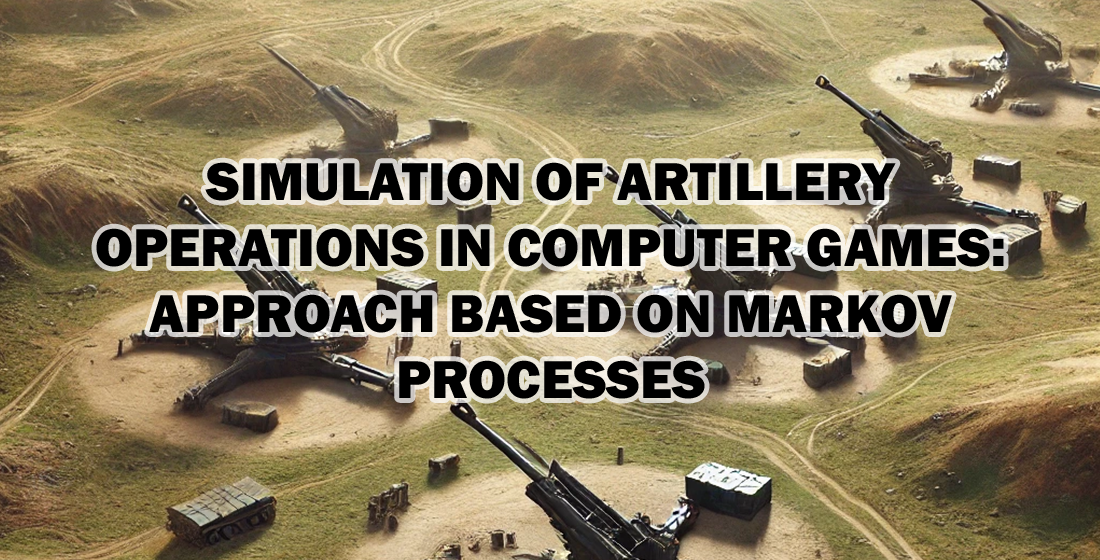Simulation modeling of artillery operations in computer games: approach based on Markov processes
DOI:
https://doi.org/10.15587/2706-5448.2024.312873Keywords:
simulation modeling, computer games, artillery operations, Markov processes, stochastic modelsAbstract
The object of this research is an approach to simulating the combat operation of artillery in computer games based on Markov processes. In modern computer games, an important role is played by the realism and plausibility of combat simulation. One of the most difficult and at the same time most interesting tasks is the modeling of artillery operations, where it is necessary to take into account numerous factors affecting the effectiveness of combat work.
The research was aimed at improving the methods and models of controlling the combat work of artillery under the conditions for the firing position change and the presence of external disturbances. The use of stochastic models allows more accurate modeling of the behavior of artillery units, taking into account the random nature of many parameters, such as projectile speed, reload time, and the probability of detection by enemy forces.
The proposed approach includes the development of a simulation model that allows determining optimal strategies to achieve maximum effectiveness of combat work. The model is based on Markov processes, which allows taking into account possible system states and probable transitions between them. This allows not only to simulate combat operations, but also to predict the results depending on different scenarios.
The results of the study show that the use of Markov processes in the simulation of combat operations can significantly increase the realism and efficiency of artillery operations in computer games. This opens up new opportunities for game developers to create more immersive and authentic gaming experiences.
The proposed model can be used as a basis for further research and improvement of combat simulation methods in computer games. It can also be used in military simulators and simulators where realistic combat conditions must be taken into account.
References
- Samčović, A. (2018). Serious games in military applications. Vojnotehnicki Glasnik, 66 (3), 597–613. https://doi.org/10.5937/vojtehg66-16367
- Lukosch, H. K., Bekebrede, G., Kurapati, S., Lukosch, S. G. (2018). A Scientific Foundation of Simulation Games for the Analysis and Design of Complex Systems. Simulation & Gaming, 49 (3), 279–314. https://doi.org/10.1177/1046878118768858
- Świętochowski, N. (2019). Rules of artillery employment in combat operations. Scientific Journal of the Military University of Land Forces, 192 (2), 280–293. https://doi.org/10.5604/01.3001.0013.2599
- Wessam, M. E., Chen, Z. H. (2015). Firing Precision Evaluation For Unguided Artillery Projectile. Proceedings of the 2015 International Conference on Artificial Intelligence and Industrial Engineering. Atlantis Press, 584–587. https://doi.org/10.2991/aiie-15.2015.156
- Moon, H. (2020). A study on modeling of artillery probable errors for improving simulation logic of artillery damage assessment in war-game models. Korean Journal of Military Art and Science, 76 (1), 331–348. https://doi.org/10.31066/kjmas.2020.76.1.013
- Boltenkov, V., Brunetkin, O., Dobrynin, Y., Maksymova, O., Kuzmenko, V., Gultsov, P. et al. (2021). Devising a method for improving the efficiency of artillery shooting based on the Markov model. Eastern-European Journal of Enterprise Technologies, 6 (3 (114)), 6–17. https://doi.org/10.15587/1729-4061.2021.245854
- Maksymov, M. V., Boltenkov, V. O., Gultsov, P. S., Maksymov, O. M. (2023). Verification of artillery fire under the influence of random disturbances for the computer game ARMA 3. Applied Aspects of Information Technology, 6 (4), 362–375. https://doi.org/10.15276/aait.06.2023.24
- Maksymova, O. B., Boltyonkov, V. O., Maksymov, M. V., Gultsov, P. S., Maksymov, O. M. (2023). Development and optimization of simulation models and methods for controlling virtual artillery units in game scenarios. Herald of Advanced Information Technology, 6 (4), 320–337. https://doi.org/10.15276/hait.06.2023.21
- Lu, T., Chen, K., Zhang, Y., Deng, Q. (2021). Research on Dynamic Evolution Model and Method of Communication Network Based on Real War Game. Entropy, 23 (4), 487. https://doi.org/10.3390/e23040487
- Shim, Y. (2017). An analysis of shoot-and-scoot tactics. Naval Postgraduate School. Available at: https://apps.dtic.mil/sti/pdfs/AD1046113.pdf

Downloads
Published
How to Cite
Issue
Section
License
Copyright (c) 2024 Oleksii Maksymov, Oleksandr Toshev, Volodymyr Demydenko, Maksym Maksymov

This work is licensed under a Creative Commons Attribution 4.0 International License.
The consolidation and conditions for the transfer of copyright (identification of authorship) is carried out in the License Agreement. In particular, the authors reserve the right to the authorship of their manuscript and transfer the first publication of this work to the journal under the terms of the Creative Commons CC BY license. At the same time, they have the right to conclude on their own additional agreements concerning the non-exclusive distribution of the work in the form in which it was published by this journal, but provided that the link to the first publication of the article in this journal is preserved.







